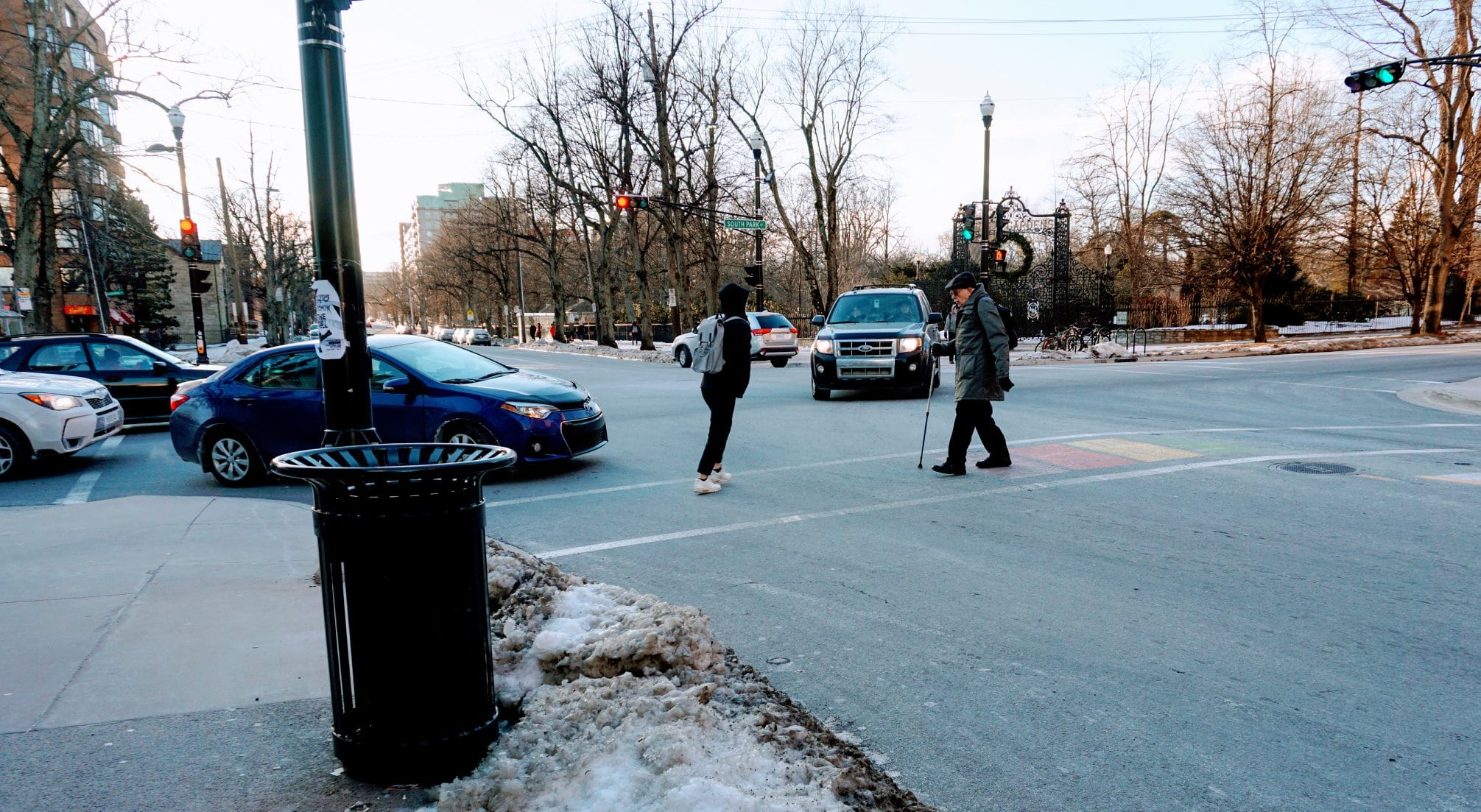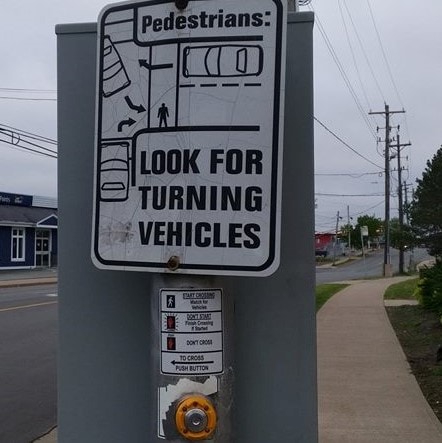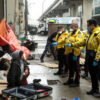
Open letter to Councillor Lorelei Nicoll, chair HRM Transportation Standing Committee, and Brad Anguish, director of HRM Public Transportation and Works.
Dear Lorelei and Brad,
I read the reports from staff relating to restricting Right Turns on Red and the Road Safety Framework. In hope it will be useful and constructive for your purposes, I have the following input.
Right Turn on Reds (RTOR)
1. Is RTOR not a significant problem for vulnerable road users?
The critical issue with RTOR is the reality of everyday user experience, not the theory on how it should be executed. RTOR causes frequent stress and danger for vulnerable road users, and is one of three extraordinarily hazardous movements they need to track constantly when crossing at signalized intersections – also left and right turns on green, accounting for a fatality following an incident at Portland street in April and a life threatening injury at a Bedford intersection in June.
Please consider a mother walking with a child in a pushchair and holding a toddler by the hand. How does she anticipate and avoid RTOR drivers (also right on green) for herself and her children? My own young son was an inch or so away from being drawn under the wheels of a RTOR driver, who was looking to her left and moved out very suddenly as we were crossing to her right. Following that incident I made sure to knock on the car hood before passing by a stationary car or shout through the car window. Not ideal.
Walk Toronto has flagged the safety issues caused by RTOR for blind pedestrians:
“Rights on red is a big issue for me,” says Daniella Levy-Pinto, a spokesperson for Walk Toronto who is legally blind. “I’ve lost count of the number of times drivers have sped to make their right turn as I start to cross, of course with the light. My dog has pulled me back.”
The user experience is accurately described by the US Federal Highways Agency (FHWA) as follows:
“A permissible “Right Turn on Red” (RTOR) was introduced in the 1970s as a fuel savings measure and has sometimes had detrimental effects on pedestrians. While the law requires motorists to come to a full stop and yield to cross street traffic and pedestrians prior to turning right on red, many motorists do not fully comply with the regulations.
Motorists are so intent on looking for traffic approaching on their left that they may not be alert to pedestrians on their right. In addition motorists usually pull up into the crosswalk to wait for a gap in traffic, blocking pedestrian crossing movements.
In some instances, motorists simply do not come to a full stop.”
The staff report states; “the speeds of vehicles are very low, however, given the requirement for vehicles to stop before proceeding..For this reason, potential severity is low”
This contradicts the medical views of Dr Rob Green, a physical trauma specialist who spoke out last year concerning the harm to pedestrians caused by right turns at signalized intersections. He called them “some of the worst collisions that we see”.
Some laws encourage particularly dangerous and non-compliant behaviour – RTOR is one of those. This video shows the reality from a pedestrians perspective. Drivers often do not stop or even slow down at all, as confirmed by the FHWA. Perhaps every decision-maker in the room on Tuesday may have experienced something similar?
2. Should RTOR be prevented at all intersections?
Regarding “no RTOR” signage at specific intersections, I am not sure how effective this is? Pedestrians report that the signs are very often ignored. Preventing RTOR at all intersections may avoid confusion and result in improved overall driver compliance and predictability for pedestrians?
The staff report states: “there is limited data evidence to support the need for, or to quantify the existence of, such restrictions on a system-wide basis”
Can staff produce any research evidence at all from any source which (based on actual conditions and practice) confirms right turns on red are safe to combine with pedestrian movements? I could not locate any, or the Quebec 2003 pilot study they refer to.
In 2002 The Alliance for Equality of Blind Pedestrians opposed the legalization of right turns on red in Quebec. Their reasons are detailed, compelling and worth reviewing.
According to data in the Integrated Mobility Plan, up to 50% of people walk to work on the peninsula. This is also where a large proportion of school children, people with disabilities and seniors rely on safe mobility. Vulnerable road user safety should be prioritised given the need to effect a transition towards sustainable transport and accessible, safe mobility for people of all ages and abilities.
Can you please propose RTOR permissions should be removed;
– At all signalized intersections within the peninsula and downtown Dartmouth
– On shopping streets throughout HRM.
– At all signalized intersections within school zones.
Perhaps it could be proposed this is reviewed for effectiveness after an appropriate period of time, and potentially introduced elsewhere?
3. What about right and left turns on green?

This sign located at a Dartmouth signalized intersection underlines to me how impossible it is for pedestrians to track and avoid drivers turning over the crosswalk from all directions.
Can any staff explain during the meeting on Tuesday how people of all ages and abilities can negotiate the triple hazard from these turning moves safely?
How can a blind pedestrian anticipate and avoid a driver turning left and right on a green light, or right on red? And a disabled or elderly pedestrian who cannot turn their head easily? If they can’t, can we have these conflicts and acknowledge this will result in pedestrians or cyclists being the victims, frequently? And that the victims are perhaps more likely to be seniors, people with disabilities or children?
Can staff confirm that in the absence of protected signal phasing (drivers are prevented from turning over crosswalks with the walk sign on through various signal types and configurations) these locations are safe for use by children on their route to school, also people with physical and mental disabilities? If not, is there any research evidence that enforcement can result in consistent safety at these locations and if so, how will this be achieved?
4. What could happen to make signalized intersection crosswalks safe to use?
Providing pedestrians with a protected phase to cross the road is a safe system for vulnerable road users. It is a system used using various methods at all intersections in European countries I know of including the UK and also Germany, as confirmed in this detailed 2003 FHWA Report.
Protected walk phases also used far more extensively in Quebec City, so I understand. This signal in Montreal combines a lengthy leading pedestrian interval with a straight-on only traffic signal, allowing traffic to flow but not over the crosswalk. Can staff confirm if this set up could be trialled and used more widely?
Many incidents, including the pedestrian fatality this year, would be prevented with safe signal timings and lights. Even a professional bus driver hit a senior pedestrian recently while turning at a signalized intersection on Jo Howe.
All turning movements at signalized intersections need to be assessed for their impact on vulnerable road user safety, not just RTOR. Leading Pedestrian Intervals which give a “head start” of 3 to 7 seconds for pedestrians have been assessed by the FHWA/US DOT in 2018 using US-wide city data to reduce incidents by 13%. This isn’t enough in the context of our disturbing long term incident data for signalized intersection locations in Halifax, also the fact all pedestrian fatalities recently in Halifax were seniors, who typically may walk more slowly.
Experts could assess how many drivers do actually yield to pedestrians at signalized intersections (research suggests around 67% drivers yield if prompted with clear signage) and consider what is required to ensure pedestrians can cross the road in genuine safety, given they lack any protection from impact. Even the best possible (with signage) 67% yield rate exposes pedestrians to very high levels of danger.
Given the clear Canadian research flagged by Transport Canada regarding the “significant” additional trauma caused by RTOR to both pedestrians and cyclists, also the virtual elimination of incidents when protected phase crossing periods for pedestrians are introduced, the requirement to assess vulnerable road safety for all ages and abilities at signalized intersections could not be more urgent.
Given signalized intersections account for approximately 40% of all pedestrian and potentially also a considerable proportion of cyclist incidents, it is requested you propose an external engineering Vision Zero expert is instructed to assess safety at signalized intersections for all vulnerable road users, and recommend appropriate safety countermeasures for implementation urgently. External safety audits are recommended by the FHWA.
Vision Zero Framework Information Report
1. Discrepancy between Provincial and HRM fatality data
Please can you clarify why there is a discrepancy between the 14 fatal collisions in HRM during 2018 in the staff report, and the Province’s data, which states there were 21 road-user fatalities in HRM?
The Province states there were four pedestrian fatalities in 2018, not the three on Halifax’s Towards Zero dashboard. The monthly pedestrian incident police report for November 2018 confirms there were three pedestrian fatalities. Then there was an additional pedestrian fatality on 14 December 2018 on Gottingen.
If the data from the Province is accurate, this has a significant impact on this comparative analysis in the staff report. It would bring the number of road user fatalities in 2018 to just five below Ottawa, which has over double the population of Halifax.And it would give Halifax the worst road fatality rate per 100,000 population.

2. The Transition from Road Safety Framework to Plan
Staff consider that the Framework is now a road safety action plan following the compilation and analysis of incident data;
“The proposed evidence-driven actions outlined for 2020 transition the Framework into the Strategic Road Safety Plan (The Plan)”
I am not sure how the countermeasures in the information report address the issues identified in the incident data analysis, also this recent research from Simon Fraser University?
For example,
1. The report states 65% of collisions involving bicycles occurred at intersections. How will this safety issue be addressed, given there will almost certainly be greatly increased numbers of cyclists and e-bike users throughout Halifax, not just on the minimum network (once complete)?
2. How will the locations with most vulnerable road user incidents be addressed with appropriate safety countermeasures/adaptations? These are multiple-lane artery roads and intersections, seen clearly on the incident location map attached to this report, also the recent research from Simon Fraser University referenced above. Road diets would be an appropriate countermeasure according to the FHWA, also fully protected/exclusive phases for vulnerable road users at signalized intersections. They are not mentioned at all.
3. The report states Leading Pedestrian Intervals (LPI’s) will be installed in ten new locations during 2020. Given the FHWA state they reduce pedestrian incidents by just 13%, how will that make any significant impact on the approximately 40% of pedestrian incidents in Halifax that occur at signalized intersections? How many more pedestrians must be hit or killed at these locations, including those with LPI’s, before we take their safety requirements seriously with appropriate countermeasures?
4. The Strategic Road Safety Framework states the following will happen in relation to pedestrian collisions: “Develop action plan for worst 10 types of collisions. Consider rates/frequencies, consistency of collision patterns and crosswalk specific assessments” . This seems critical. Has this happened?
Without a road safety action plan which outlines appropriate countermeasures that address the main causes of incidents affecting vulnerable road users at the locations with most incidents, it is difficult to appreciate how the Vision Zero targets for vulnerable road users will be achieved.
Could councillors propose that a Vision Zero engineering professional consultant should be instructed to advise upon and suggest revisions to the road safety action “plan”, along with the signalized intersection safety audit requested above?
With best wishes
Martyn Williams
If you walk, cycle or use a wheelchair and are affected by road safety issues, please join HRM Safe Streets for Everyone. If your local crosswalk needs a crosswalk flag, please contact the Crosswalk Safety Society. Please remember to report issues affecting your safety to our municipal authorities using the 311 service.
With a special thanks to our generous donors who make publication of the Nova Scotia Advocate possible.
Subscribe to the Nova Scotia Advocate weekly digest and never miss an article again. It’s free!




I am a wheelchair user now but many years ago, when I stepped off the curb to walk in the crosswalk, a driver who was turning right nearly hit me. He didn’t see me because he was looking left to wait for a break in the oncoming traffic. Fortunately, he was creeping slowly around the corner as he was looking left so I was not even slightly injured. I smacked my hands down on the hood and he slammed on the breaks. He scrambled so fast to get out of his car, he nearly strangled himself with his seat belt, shouting, are you okay. As I walked past him, I yelled, stupid idiot. I was really shaken up. After that, I never crossed a street without first making eye contact with any driver nearby.